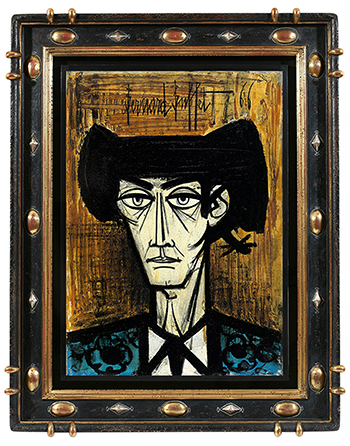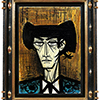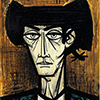EXHIBITED:
La Corrida , Galerie David et Garnier, Paris, 1967
ILLUSTRATED:
Yann le Pichon, Bernard Buffet , Galerie Maurice Garnier, Paris, 1966, color illustrated, p. 137, no. 600
This painting is to be sold with a certificate of authenticity issued by Galerie Maurice Garnier, Paris.
Catalogue Note:
“I VIEW TORERO AS A NOBLE, HARD-FIGHTING ANIMAL - THE KING OF BEASTS.”
-BERNARD BUFFET
The post-war expressionist master Bernard Buffet cultivated art from war, and led the entire world to become infatuated by his sense of melancholy. Japanese people called him “the Pope of French art.” However, for political reasons, the French art community was source of unceasing criticism. With the exception of works donated by collectors, officials had only purchased one work by him for a collection. The wealth Buffet gained from his works and a sense of internal serenity accompanied him throughout his life. In his later years, illness prevented him from holding a brush and ended his will to live. In October 1999, he covered his head with a plastic bag which was printed his name on, and left this world through a tragic ending filled with endless regrets.
Born in Paris in 1928, Buffet grew up on the coast of Brittany. With a passion for biology, he had a delicate and sensitive disposition. Difficulties in schoolwork did not dim his extraordinary talent in art. In 1948, his painting, The Drinker (Le Buveur), was exhibited in the Galerie Drouant-David and later collected by the City of Paris Museum of Fine Arts. In the same year, the artist met art dealers Emmanuel David and Maurice Garnier, who appreciated his talent and signed a contract to represent him. Buffet later went on to receive the “Prix de la Critique” award and achieved fame. In 1955, at just the age of 27, Buffet was elected by the magazine Connaissance des Arts as the “one of the ten most outstanding painters of the post world war era.” In 1958, when he held his first retrospective exhibition, he was praised by the media as the successor of French realism painting. After that, this shy youth slipped into his role as an artistic genius to remain always in the spotlight.
In the early period to Buffet’s career, the content of the young artist’s paintings was generally simple. The themes of the paintings were typically comprised of everyday still-life objects, self-portraits, people in his hometown, and his studio. In these early works, the figures tended to display large eyes and thin limbs, echoing the pain left by the war. They also reflect to viewers of different generations the depression and poverty of the environment of that era. French president Jacques René Chirac once stated, “Buffet concretely illustrated the suffering of post-war France. He wholeheartedly expressed the situation of weakness, suffering, and poverty. ” The artist eschewed the depth of a field with a single visual focal point. Rather, he utilized the sizes and positions of objects to create a sense of space. The lack of material resources is reflected in the thin pencil lines and the neutral tones of gray and white. The lightness and thinness of the paints in the picture are like the creator’s thin body. Buffet’s strong personal style was like a shot of epinephrine that revived the arts in post-war Europe, which had been in turmoil, awaiting rebirth.
In mid-1950s, the material conditions of Buffet’s life improved, and his creative theme expanded to larger scales. The perfect composition and the creative themes—matadors, circuses, and dramatic topics full of tension—resulted from the solid training he had received at the Ecole Nationale Supérieure des Beaux-Arts in his early years. He also paid homage to early masters such as Gustave Courbet and Rembrandt Harmenszoon van Rijn by reinterpreting their masterpieces. This act also revealed his ambition to exceed the masters, to inherit and surpass their position in art history.
The year 1958 was a major watershed for the artist in his personal life and in his creative work. In mid-January of that year, he held his first retrospective exhibition at Galerie Charpentier. The exhibition attracted 8,000 people to the opening banquet, and over 100,000 people purchased tickets to visit the exhibition. Also in that year, his lover of 8 years, Pierre Bergé, left him for fashion designer Yves Saint Laurent. Buffet cooperated with François Sagan, the author of Bonjour Tristesse, on composing the screenplay for a ballet and on the stage costume design. In the summer of the same year, he met Sagan’s good friend, model Annabel Schwob de Lure. Buffet married de Lure on December 12, 1958, and thus began their 40- year marriage.
In 1967, David et Garnier Galerie held a solo-exhibition, La Corrida, exhibiting a series of oil paintings of de Lure wearing Matador costumes. From October 2016 to March 2017, the City of Paris Museum of Fine Arts held the Buffet Retrospective Exhibition, the first to be held by official French museums. The exhibition featured a gigantic painting, La Corrida Desplante de Rodillas (1966), which was 5.5 meters long, as the piece that greeted visitors at the exhibition entrance. In the painting, the golden, solid lines leave no space. The blood of the beast is pouring out. The matador, in a bright red cloak, stands still, his face indifferent. On the right, a matador in green stands with his back to the viewer. The structure of the picture, with this matador showing only his upper body, creates a sense of presence for the viewer, as if they were there. The time and space are consolidated in the gigantic canvas, creating a solemn atmosphere.
As a bullfighting enthusiast, Buffet had incomparable passion for this traditional cultural activity from Spain. He once commented, “I view torero as a noble, hard-fighting animal - the king of beasts.” He appreciated the fatal attraction between the bull and the matadors, a fate between the two that is destined to end in tragedy. The trapped beasts are provoked and attacked in turn, but they cannot escape death. The fighter is in a brilliant outfit that shines under the sun, but it provides no protection from the beast’s piercing horns. His long sword seems shiny and sharp, but facing the threat of an enormous beast, it can only function at critical moments of life and death. A dance full of violence and desire, through ritualization, becomes a process of a performance, adding an element of drama to this brutal activity and diluting the audience’s fear for death.
This stimulation resonated with Buffet’s feelings and became his motivation for creation. On his 30th birthday, he purchased the Château de l’Arc, where he installed a large studio, messy and filled with paint and abandoned canvases, that only his wife, Annabelle de Lure was allowed to enter without permission. In fact, tall and slender, Annabelle was often Buffet’s creative inspiration. The Matador series, begun in 1958, was completed with her modeling in matador costumes. At an interview, she stated that it was Buffet who introduced her to the art of bullfighting: “Buffet led me to the world of bullfighting. The first time I entered the arena to watch the performance, I was almost immediately fascinated by its amazing sense of aestheticism…I still remember when I posed as a model. Looking back, it is as if happened only yesterday. ”
The auction piece La Corrida-Tête de Toréro, completed in 1966, specifically uses a portrait to emphasize the perseverance of the matador’s facial expression. Compared to the theatrical sense in large-scale works, this piece can more effectively focus on the spirituality of the character. The artist parted with his earlier grey tone and pencil lines, the melancholy and moroseness of the Clown series. The painting highlights the focused expression of the matador, as if he is facing an enormous monster. The matador is portrayed with simple and powerful lines. He wears a black hat. The braid toward the back brings out the depth of the space. The brows are thick, and the eyes are tough. The muscles at the laugh lines are tight, and the line between the nose and lips is elongated. The thin lips are pressed tight. The chin is angular. The five features of the face form a perfect T. Replacing the gold lines in the skyblue suit, the creator uses curling black lines to depict the details. By intersecting thick and thin lines, Buffet creates a sense of three dimensions without using shading. Although it is in the form of a bust, like those of medieval aristocrats, the place that should hold the name of the figure has instead the artist’s signature, strong and powerful, hanging high above the painting, giving the viewer the illusion that this is a self-portrait of the artist in matador clothing. This painting echoes this period, during which Buffet established fame in the painting scene, having completely constructed the confident mentality of his own painting context.


